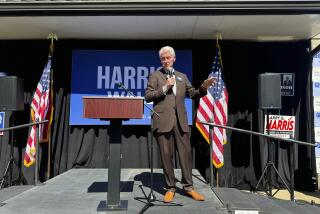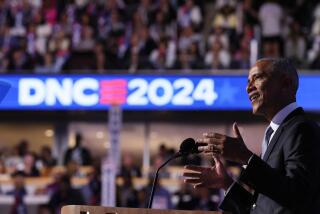To get ahead, she looks back
- Share via
HARRISBURG, PA. — Sen. Hillary Rodham Clinton nodded knowingly last week as Joe Rebarchek described his struggle to pay for his oldest daughter to attend Villanova University and still save tuition money for his two younger children.
“I hear about this everywhere,” Clinton said at the Capitol Diner, her voice tinged with sadness.
The New York senator looked across the crowd of supporters in the ‘50s-style dining room with flying-saucer-like lights and said she was able to go to law school nearly 40 years ago only because she had a low-interest loan from the government.
“At that point in this country’s history, we made a really big investment in young people,” Clinton said. “That was a part of what our country did. And I want to get back to that.”
There is a lot that Clinton wants to get back to these days.
On the presidential campaign trail, Clinton talks of reviving steel mills, rebuilding bridges, reprising the war bond campaign of the 1940s and recapturing the excitement of the Apollo space program in the ‘60s.
Clinton, a baby boomer born in 1947, did not initially campaign on the triumphs of America’s past. But as she works to narrow Illinois Sen. Barack Obama’s lead in the race for the Democratic presidential nomination, she is weaving a strain of nostalgia into her speeches.
Her message seems to resonate in states hit hard by the shutdown of once-booming factories.
“I got out of the Air Force in 1961, and I could barely afford to go to school. But I got a college degree with the GI Bill,” said Bob Spencer, a 69-year-old retiree from Louisville, Ky., who applauded Clinton’s invocation of the past at a rally last week. “I think that’s what Democrats need to get back to.”
Clinton decisively won Ohio last month on the strength of her support among white, working-class voters. And she is relying on them to sustain her candidacy in the next three months as the last states -- including Pennsylvania, Indiana, Kentucky and West Virginia -- go to the polls before the primary season ends in June.
“Change has not been all that positive for a lot of people here over the last 20 years,” said Tom Murphy, a former mayor of Pittsburgh. “Their kids may have moved away. Their factories may have shut. Their jobs may have disappeared.
“There are a lot of people here who fondly remember the old days,” he said.
Clinton has family roots in the industrial heartland of eastern Pennsylvania, where her grandfather spent decades as a factory worker in Scranton.
She began her 2003 memoir, “Living History,” by recalling the prosperous years that followed World War II, when her father, a Navy veteran, started a business and bought a two-story brick house in the Chicago suburbs to raise a family.
Yet Clinton, whose public image has been shaped by her years as first lady, did not launch her presidential campaign with a sepia-toned message. Her pitch was largely built on her experience, to contrast with Obama, 46. Today, Clinton still frequently cites her work in the Senate, the White House and elsewhere to argue that she is better qualified to be “commander in chief on Day One.”
But since the emergence of working-class voters as her core constituency, Clinton has increasingly shaped her message to match their sensibility, said Mark Mellman, a veteran Democratic strategist.
“It’s common to say elections are about the future. They’re not,” he said. “They’re often about the past. . . . And effective campaigns often draw on those historical analogies.”
Clinton reached for one such analogy after another during recent campaign swings through the Midwest and South.
In an old gymnasium in Hammond, Ind., a steel town outside Chicago, Clinton called for issuing federal bonds to rebuild roads and bridges, reminding several thousand supporters of a time when the government helped keep the steel mills running around the clock.
“During World War II, we had war bonds, didn’t we?” she asked. “Why don’t we let Americans buy bonds to rebuild America? . . . We can again put thousands of Americans to work.”
In Raleigh, N.C., Clinton spoke of how men of her father’s generation took advantage of the GI Bill to go to college after the war and called for “a 21st century GI Bill for our young veterans coming back from Iraq and Afghanistan.”
Clinton wants the federal government to pay for 36 months of tuition, fees and living allowances for those who complete four years of active-duty military service.
She also has proposed new tax credits and bigger federal grants to help students pay for college.
In Madisonville, Ky., she cited President Kennedy’s call to put a man on the moon as she pledged to set up a $50-billon “strategic energy fund” to make the U.S. a leader in alternative energy technology.
“We can excite the imagination of our young people the same way many of us remember being excited by the space race,” she said, as the crowd roared its approval. “I didn’t have a clue about how we were going to get a man to the moon and then bring him back. But I never doubted we would, because that’s what Americans do.”
Arline Petroff, a 73-year-old retiree from Philadelphia, cheered when she heard Clinton invoke the Apollo program during a rally at a former steel plant on the Delaware River that now manufactures wind turbines (though with far fewer employees).
“It was such an exciting time,” Petroff gushed. “People worked. People had jobs. . . . We were Americans. We could do anything.”
--
More to Read
Sign up for Essential California
The most important California stories and recommendations in your inbox every morning.
You may occasionally receive promotional content from the Los Angeles Times.











